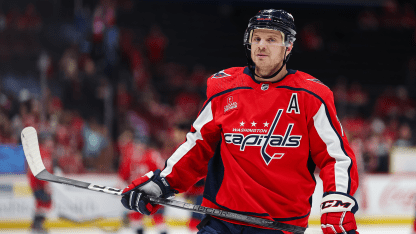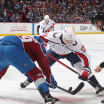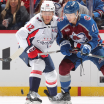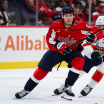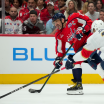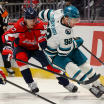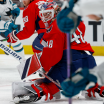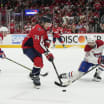Over the course of their half century NHL existence, the Capitals have had a number of elite defensemen patrolling their blueline. Hall of Famers Rod Langway, Scott Stevens, Larry Murphy, Phil Housley, and a slew of other excellent blueliners such as Calle Johansson, Dmitry Orlov, Sergei Gonchar, Sylvain Cote and others have all pulled on a Capitals’ sweater for hundreds of regular season games in the District.
Among them all, only John Carlson has started young enough, played effectively enough, lasted long enough, stayed healthy enough and been as crucial to the team’s success to play in 1,000 games here in D.C.
From his NHL debut as a 19-year-old in November of 2009 to the odometer turning 1,000th game against Boston on March 30, Carlson has been a reliable workhorse, and he continues to exhibit those qualities this season at the age of 34, as one of only two Caps to skate in each of the team’s first 76 games this season.
“It was special,” said Carlson, in the aftermath of his 1,000th game. “Like I’ve said, it’s special to play in this League, and it’s special to play for one team – and a great team – meeting lifelong friends and getting to battle, have some ups and downs and triumphs, and it’s been a heck of a run.”
Naturally, Carlson scored in his 1,000th game; he’s always been preternaturally confident, calm and unshakable in big moments, and he’s always had a tendency to shine when the spotlight is at its brightest. He has also been a rock, a consistent presence and force on the Washington blueline virtually since his arrival in Washington.
In the first 1,003 games of his NHL career, Carlson has logged less than 10 minutes in only three of those contests, and he departed each of those three games with injuries that kept him out of multiple matches afterwards.
At the other end of the spectrum, Carlson has played 20 or minutes in 917 games, he has logged 22 or more minutes in 756 games, and he has skated 25 or more minutes in 313 games, including 42 such games this season alone. Carlson’s average of 25:42 in nightly ice time this season is the highest figure of his 15-year NHL career, and the second highest average in the League this season, just behind the Kings’ Drew Doughty (25:50), himself a member of the draft class of 2008. Doughty was drafted second overall in that Draft, the first of a dozen first-round blueliners; Carlson was the last.
Carlson arrived in D.C. with only 48 games worth of regular season AHL seasoning, plus another 29 games of Calder Cup playoff experience scattered over two playoff runs, both of which resulted in championships. But once he arrived, he didn’t require much nurturing and certainly didn’t need to be shielded situationally.
Langway, Murphy, Johansson and Cote were obtained in trades, and Housley was signed as a free agent. Stevens, Gonchar and Orlov were Washington draft choices. Carlson was a bit of a hybrid; he was a Caps’ draft selection, but Washington had to work a clever deal to get him.
Sixteen summers ago in Ottawa, general managers and talent evaluators gathered at the 2008 NHL Draft to divvy up what was touted as a strong draft class replete with upper echelon defensemen. Draft previews predicted as many as 14-16 defensemen could be selected in the first round of the ’08 draft, and while that projection fell short, the 2008 NHL Draft was the first in this century in which more than half of all the players chosen eventually ascended to the NHL.
Here in D.C. at the time, the Capitals were a couple months removed from their first playoff voyage of the Alex Ovechkin era, a first-round exit in overtime of Game 7 at the hands of the Philadelphia Flyers. In the previous six NHL Drafts, the Caps had harvested a dozen first-round draft picks, spending half of them on defensemen.
Three of those six defensemen – Steve Eminger, Mike Green and Jeff Schultz – played in that series against the Flyers, and the Caps were extremely high on their most recent first-rounder, Karl Alzner, the fifth player chosen overall in 2007, the highest the Caps had taken a defenseman since Scott Stevens in 1982.
Even with a number of promising young defensemen in the system, then-Caps’ GM George McPhee hinted that Washington still might want to dabble in the defense market with its first-round pick in ’08, the 23rd overall selection.
“It’s hard to say whether it will be easier to trade up,” McPhee said, days before the draft. “We won’t know until we get there. But there’s no doubt that there are some very, very good defensemen in this draft, more than in any draft we’ve seen, maybe ever. And a lot of them might be able to play right away. They’re that good. I don’t know whether we’ll be able to move up or not. We will if we can, but there has to be a willing [trade] partner there.
“On the other hand, if we can’t, we might just get a guy that we really like right where we are sitting. There are enough good players in this draft that we expect that there will be some good players at 23. We got some good players in Schultz and Green at 27 and 29 [in 2004]. We’d like to have that kind of luck again.”
The Caps actually took center Anton Gustafsson – son of longtime Caps’ pivot Bengt Gustafsson at No. 23. But as the first round progressed, there was a defenseman still on the board who piqued Washington’s interest. McPhee packaged Eminger and the Caps’ third-round pick in 2008, and Philadelphia – having taken blueliner Luca Sbisa at No. 19 with the highest of its two first-round choices – made the deal, sending the Caps the 27th overall pick in return.
McPhee walked up to the podium and announced that the Caps would take defenseman John Carlson, from the Indiana Ice of the USHL. The scouting reports on Carlson were glowing.
“John Carlson is a big, burly defensemen, he is a real good skater and a strong skater,” was the assessment of Central Scouting’s Jack Barzee. “He runs the power-play from the top of the umbrella and he has a very heavy shot. He's a very self-assured kid and rightfully so – he's a boy, yet in a man's body and very physically strong ... I knew when I first saw him that he was a first-round pick. He was a guy I had seen before as an under-ager. He had all the tools – size, skill, physical presence and charisma.”
“When I look at John Carlson, I just see pro written all over him,” said Charlie Skojdt, Carlson’s coach at Indiana. “He's big, strong, can absolutely rip it. He's good on his feet and agile for a big kid. He's poised at all times and just has the mind for the game. He never gets rattled ... as a coach, you know what you are going to get every time John goes out on the ice."
In those days, McPhee was pretty tight with ex-Caps’ center Dale Hunter, who was coach of the OHL London Knights, a team he owns and operates along with brother Mark. Carlson pivoted from his original decision to play collegiate hockey in Massachusetts, opting instead to skate for Hunter’s Knights squad.
“He’s got very good hockey sense,” said McPhee of Carlson, on draft day in 2008. “He is skilled. He’s got good hands. And he’s got some powerful legs. We have to teach him how to train; get him into shape. What appealed to us is he is going to play for Dale Hunter. We talked to Dale about that today. Dale will whip him into shape and teach him how to play.
“We liked him, and we like his base attributes. But knowing he was going to Dale to refine everything and be taught how to play, that sealed it.”
Before Carlson ever played a single game in Washington, Hunter – typically a man of measured words – spoke rhapsodically of Carlson’s potential, in a 1-on-1 interview with us in the fall of 2009.
“We drafted him in our league in the second round,” says Hunter. “We didn’t know if he was going to come to our league or not; he had some choices to make. A month later, the Caps drafted him. My brother Mark scouted him, and he liked him a lot. We picked him and he came to our team. He was feeling it out early, but as the season went on, he got better and better and better and better and better. He is one of the best [defensemen] in our league. He can skate, he’s big and he’s smart.
“He likes the game. He always plays with a smile on his face, like a lot of the players here. Ovechkin and these guys, you can see where they enjoy the game. It’s nice to see as an ex-player. Kids come here and they play hard and they enjoy the game. It’s not just a business, it’s a hockey game. It’s a kids’ game and we’re lucky to play it.
“He is going to be a good one. He still has one year of junior [eligibility] left, but he can come here and play. He’ll be good enough to play here or in Hershey, depending on how he develops. But he’s got a good shot at playing here next year.”
Hunter went on to compare Carlson to one of his Hall of Fame teammates from his playing days in Washington.
“He is just a real smart player,” said Hunter of Carlson. “Larry Murphy was a very smart player. I think Johnny skates a little bit better than Larry; I am not saying that against Larry. But Larry was a very smart player also. He played a long time and won Stanley Cups with Pittsburgh and Detroit.
“When he was here, as a forward you wanted to be on the ice with him. And Johnny does fight a little bit, too, so he adds that dimension also. But as a forward, I think players like Backstrom and Ovechkin and these guys will like him on the ice. He sees the open guy and makes a great first pass where he springs these guys, especially with their speed.”
By the time Hunter offered the above assessment of Carlson, the teenaged defender had already posted a terrific first season in the OHL, rolling up 23 goals and 98 points in just 73 games, 59 in the regular season and 14 in the playoffs. Once the Knights’ season was over, Carlson reported to AHL Hershey, where he notched a goal and three points in 16 playoff games, helping the Bears to a Calder Cup championship in the process.
Carlson debuted in Washington on Nov. 20, 2009 against Montreal. Among the players in that game, only Carlson, Ovechkin and then-Canadien Max Pacioretty remain active in the NHL. There was nothing memorable about Carlson’s debut; it was a run-of-the-mill, early season game, and he skated 17:24. After playing in two more games, Carlson was returned to AHL Hershey. But then-Caps’ coach Bruce Boudreau saw enough from that debut contest to know the Caps had something special in Carlson.
“He’s going to be a good player in this League for a long time,” said Boudreau, on that night in November of 2009.
Less than two months after his NHL debut, Carlson scored the game-winning overtime goal that delivered the gold medal to the 2010 U.S. World Junior team in the IIHF World Junior Championship that December.
After scoring that epic goal on the sizeable World Junior stage, Carlson was recalled to Washington again, and he spent the remainder of that 2009-10 season bouncing between Washington and Hershey. Carlson made his Stanley Cup Playoff debut that spring, and despite being a 20-year-old on a Presidents’ Trophy winning team, he skated in all seven games, finishing fourth on the team in playoff scoring with four points (one goal, three assists), and averaging 20:14 per night in ice time, third among Washington defensemen.
Carlson’s first playoff goal was massive; it was a game-tying tally late in Game 2 against Montreal, a goal that forced overtime and allowed the Caps to win in the extra session when Backstrom completed the hat trick. Carlson’s first Stanley Cup Playoff goal prevented the Caps from falling into an 0-2 hole in that series, a first-round set they eventually lost in heartbreaking fashion anyway.
Again, Boudreau was impressed by his young blueliner.
“There’s just something about him,” said Boudreau of Carlson after that game. “I mean, glory follows him. Some guys get that. I’ve said it before. They come up in the ninth inning with the bases loaded and they’re the ones that do the damage. I think John Carlson in his career is going to be like that.”
When Carlson came to training camp in 2010, he was a full-fledged NHL player who had already won World Junior Gold and played on two Calder Cup Champions.
By this time, Dale Hunter wasn’t the only one who saw a bright future for Carlson.
“I remember when he first got here,” says Caps’ center Nicklas Backstrom. “They sent him to us after he scored that [World Junior Championship] goal. He had been up earlier for maybe two or three games – maybe a couple more – and then they sent him down. But as we saw him then when he played here, he was very mature for such a young defenseman. And just the way he carried himself too, he was very mature. It doesn’t happen that often that a defenseman is ready that quickly. But he was. And he probably could have been ready from the start of that [2009-10] season. But there’s always moving parts that you have to consider in stuff like that.
“But he was always very mature and very consistent, and that was right from the start, when he started playing with us. And now, he’s grown into this superstar defenseman that no one talks about. But I think he is the kind of guy that doesn’t need the spotlight on him, even though one year I thought he should have gotten the spotlight; he should have won the Norris [Trophy]. But at the same time, I think he felt that everyone around him knew that he should have won it. And that’s probably the best credit you can get; the credit from your teammates and your organization, from friends and family. They all knew that he should have won that year. Hopefully, that was enough, that he got credit from us, and that we knew he was the best defenseman that year.”
In his brief time in Hershey, former Caps’ netminder Braden Holtby was one of his teammates.
“Carly and I came up together at the exact same time; we were black aces in Hershey together and lived in the hotel together, so it was right from day one,” says Holtby. “When you look at Carly, he’s got so much natural talent and natural ability, and right from day one you could tell this guy was a step above everyone else. It was really fun to be in that situation where we were basically the same age, growing up. And just to see him grow through the years from being a young, cocky kid coming in – which helped him, because he wasn’t scared of anything or anyone – and then seeing him through family stuff, having kids, becoming a veteran guy, a leader. The evolution with him was so great that it was really fun to be a part of, just to see him develop. And obviously the talent and everything was there from the start, and he has been a pleasure to watch and to play with.”
Holtby was drafted in the fourth round of that fertile 2008 Draft, and the two were the last two core pieces of the dominant Caps teams of the previous decade.
“I remember when he came into the League and was with us in the playoffs against Montreal, and his confidence was on a different level,” says Ovechkin. “He seemed like he had been playing the game a long time; he was never afraid to make a good pass, never afraid to take a shot. And you can see how he developed. He became a leader, he became a Norris Trophy candidate, and he became a very solid player. I was lucky to play with great players and great persons like Carly.
“I think he was learning a lot from [Mike Green]. When he came to NHL, he was on the second unit and he was watching Mike Green and what he could do on the blueline. He was the best guy out there, and Carly was in the right hands. He learned a lot and obviously he has a better shot than Greenie, power wise. I think when you have someone you can look up to, it helps you a lot. And how I said, he was so confident for his level so that he could easily be a number one [defenseman] right away when he came into the League.”
Carlson’s 249 career power-play points are a Washington franchise record for defensemen, and they’re the sixth most of any defenseman in the League since the outset of the 2010-11 season. In the decade of the 2010s, Washington’s power play clicked at a 21.6 percent success rate, tops in the NHL over that span. Carlson’s ability to quarterback the unit from the point was a big reason for the Caps’ success with the extra man over that span.
From opening night of the 2010-11 season through the middle of the 2015-16 season, Carlson played in 412 straight games. Although he has missed handfuls of games here and there since then, Carlson has maintained a remarkable level of consistency throughout his 15 NHL seasons, and he continues to do so to this day.
“I think the thing that stands out to me about him as a hockey player is the most important thing,” says Backstrom. “I personally think consistency is the best quality in a hockey player; it’s my number one thing. If you’re consistent, that’s worth a lot. And to have a defenseman of his caliber be that consistent, it’s just very fortunate. He’s grown up to be a leader in this organization. He’s won a Cup in this organization, he’s involved in this community, and he’s a father of four. I’ve seen it all, from when he was younger to where he is right now, and his journey has been amazing.
“We clicked right from the start, and now we have kids growing up together and playing sports together. Seeing him develop as a hockey player has been amazing. And to me, that’s who he is. He is a hockey player, he is very consistent, and people took him for granted.”
That consistency has made Carlson unique among his peers in the League. Even with a gruesome head injury – a fractured skull – that cost him half of the 2022-23 season, Carlson still managed to be the third of those dozen first-round defensemen from 2008 to reach the 1,000-game plateau. But his true value is locked within those games, in both the amount of minutes he is able to shoulder on a nightly basis, and in the situations in which he is deployed.
“With Carly, he’s been one of our workhorses since I’ve been here, so the last decade,” says Caps’ right wing Tom Wilson. “He’s such a workhorse, and he thrives on heavy minutes, but it seems like he just does it with ease. Obviously, it’s a grind. And obviously, every game is hard, and he’ll tell you that. But from a teammate’s perspective, he goes out and he plays 20 to 30 minutes every night, just skating up and down the ice. He does it with ease; he makes plays. But there aren’t many defensemen around the League that have done what he has done for so long, just be that steady rock back there that has the ability to play on the first power play. That’s why he’s so unique, and that’s why he is so important to us. There’s only a handful of guys that can do what he does.”
From the beginning of the 2010-11 season to now, among all NHL blueliners who have skated in at least 500 games over that span, only two have averaged three or more minutes per night on the power play and two and a half or more minutes per game on the penalty kill. Those two defensemen are John Carlson and Shea Weber.
“It’s an impressive stat,” says Caps’ coach Spencer Carbery, “but it’s something that we have become very fortunate and accustomed to – and this is a credit to him, and why you have to put his name in a Hall of Fame type of class when you look at those names – because of what he does in every situation. He’s not just a point producer that is just able to play the top of the power play, and able to play that for 20 years. He’s playing that, plus he’s playing on the penalty kill, plus he’s playing 5-on-5 when you need to defend a lead, and when you need to score a goal. That ability and uniqueness, there’s very few that have logged minutes in all those situations throughout his career, so it’s just another feather in his cap, and why he is such a special player and why he has had such a successful career.”
Carlson not only plays one of the most visible positions in the game, he excels in all of those situations that Carbery mentions. That’s one of the reasons he keeps eating all these hard minutes; each of the seven head coaches for whom he has played during his time in Washington has recognized his value and has trusted him to shoulder a heavy workload.
“I think it’s just harder minutes, a harder position to play longevity wise, because it is just more magnified,” says Carbery. “You can get through games as a forward; you sort of blend in. But as a [defenseman], to play into your late thirties, if you’re not able to keep up with the pace of play, skating, and reads, you get exposed. That’s where it becomes a little more challenging for a defenseman to play that long, and to be able to play at a high level. It just speaks to John’s career again, what he’s been able to do over such a long period of time.”
“I think it’s one of those things where the forwards sometimes get all the credit,” observes Wilson. “Backy and Ovi – the guys that have been here as long as he has – you get a little more limelight when you’re on the offense and you’re scoring a lot of goals. But what he does is incredible, and you know exactly what you’re getting, and it’s first class.
“There may not be another player on our team that is such an X factor. When he is going and he is playing both ends of the ice, we’re winning games. He is such a huge piece of our team. He’s just a guy that you know, ‘Yep, he’s in the lineup tonight,’ and ‘Yep, he’s going to play a ton of minutes, and he’s going to play them really well, and probably have a couple of points.’ As a teammate, he leads in a way that is exactly that; you just know he is going to show up every day, ready to work. You know he is going to go out there and be above and beyond the rest, and you know is just going to do it with ease, and he is going to put his head down and keep going.”
While longtime teammates such as Backstrom, Holtby and Ovechkin readily sing Carlson’s praises, so too do more recent teammates whose own careers began after his.
“He’s a guy who has obviously been around a long time, so he’s been through a lot of coaches, GMs, a lot of different teammates and a lot of different teams,” says Caps’ center Nic Dowd. “He’s been on Presidents’ Trophy-winning teams, he’s been on a Stanley Cup-winning team, playoff teams, and he’s been on playoff teams that have lost in the first round. You don’t get to that spot without being a good person and a good teammate, and you don’t stay in the same organization for a long time. Also, he just has so much experience in so many situations, and I think that’s why you see him as a player on the ice who does absolutely everything.
“The thing I learned about him from playing with him is, you read so much about him being an offensive defenseman. But I think what people don’t realize is that he is honestly one of the top 10 defending defensemen in the NHL. He plays against the top guys in the League every single night, he’s asked to play in the [defensive] zone, and he is asked to play on the penalty kill. But the things that people notice – because they’re sexy – are the power play and his offensive production. But I would say that we here in this room know better. The Washington Capitals aren’t as offensive of a team without Johnny’s capabilities at playing defense.”
Blueliner Martin Fehervary debuted in the NHL on opening night of the 2019-20 season, and he now has more than 200 games under his belt, many of those with Carlson as his blueline partner.
“Carly, first of all he's a great person, a great guy and leader,” says Fehervary. “He was always so kind to me and talkative whenever I needed help or something like that. He helped me all the time, and he stayed in contact with me during the summer too. He's got a huge personality and I felt really comfortable with him out there.
“Whatever happens on the ice, he never blamed me or something, he just always helped me to think positive and that really helped me. I just tried to work hard and help him as well. I really like our relationship and I love playing with Carly.”
When Carlson’s NHL journey began at that NHL Draft in Ottawa nearly 16 years ago, he couldn’t have fathomed how his career and his life would play out over the course of his NHL career. He came to D.C., he became a fixture on an elite NHL team, he made lifelong friends in the Washington locker room, he carved out a career that might – and should – one day land him in the Hockey Hall of Fame, and he met and married the love of his life – his wife, Gina – and they are now the parents of four children.
“On a drop of a hat, careers can end,” observes Carlson. “And on that drop of a hat, roles that you think are never going to get filled, need to be filled. For me, if you asked me in my first couple of years when Greenie was here, [I would have said] that was never going to change. I was always going to be a second power play guy. And if he stayed here, what would I be? I don't know.
“I have the confidence in myself to know I could do it, but it would have been different, my career would have been different, one way or another, whether it was here or maybe I would go somewhere else, or they would trade me somewhere else or whatever. But so much of success has to do with your opportunity. I’ve come into a great organization with great leadership from the beginning. And we’ve had great players.
“Especially in my first few years we had an older team that had very good lineage in terms of all of those things. And I think that led those two guys that are here now on a great path that I kind of swooped in with over the years, and I’ve tried to uphold that now. If you ask guys that come around, I think we’ve got a great organization here that expects to win, that wants to win and that is hard on each other but has fun. I think that everybody that comes here, will tell you that they love to play here, and that's because of that.”
Carlson has become part of that culture that has attracted and kept a number of players here over the years, and he has made the D.C. area his offseason home as well. His family and friends are surely thrilled to see how his career has played out and are excited for what’s ahead for him, and that’s true of his teammates as well.
“We watched a big video about Johnny’s hockey journey this morning,” said Wilson on the morning of his teammate’s 1,000th game in the League. “You see him starting as a young pup in Hershey and being drafted, and then it finishes up with him having such a full life, such a full family. And I’m sitting there pretty emotional, because I’ve been there to watch a lot of that happen.
“Lucca, his oldest son, we’re buddies. If he ever needed anything, I’d be there for him. He comes to the rink, and he says, ‘Hey Tom, what’s up?’ and hangs out with us. It’s pretty cool. What we do is not easy on the families. Gina and all the kids, I’m very proud of their family, I’m very proud of John and I’m proud of Gina; the kids are awesome. It’s been really cool to have a front row seat to see Johnny and all he has done, and all his family has accomplished in his 15 years as a Capital.”
That goes for the rest of us here in the DMV, too. Congratulations to John Carlson on a magnificent achievement and career; as Wilson says, it’s been a sublime pleasure to be able to witness and marvel at what he does on a night in night out basis for a decade and a half, and hopefully that pleasure will stretch for several seasons more ahead.

